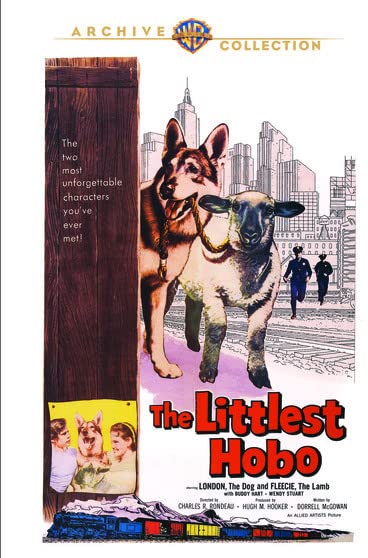
A stranger wanders into town and, amid the prejudices and fears of many locals, changes the lives of people before the unknown individual exits just as swiftly as they appeared. Such a scenario has been seen and heard countless times before (many of us have indeed encountered such characters in our life stories), but in the instance of 1958’s The Littlest Hobo, the “stranger” factor is upped considerably by making its protagonist one cute, very talented German Shepherd. Yes, The Littlest Hobo is essentially another Lassie clone (also see: the Warner Archive’s recent release of My Pal Wolf) manufactured to ensure the kennels of cinema are never in need of barking heroes looking for new homes, but ‒ truth be told ‒ there’s something alluring about this particular film.
Certainly, I was not the only one out there to find the odd family friendly vehicle slightly enticing, as the tale was turned into a Canadian television series twice ‒ once in 1963, and then again in 1979 ‒ the former being the most popular of the three different versions, and the automatic “go-to” memory for most people who recall the title in general. Here, however, we witness the birth of the litter, with one of many canine performers who would be credited as “London” by trainer Charles P. Eisemann riding into a small, sleepy town that looks suspiciously like Los Angeles. Taking his cue from a stereotypical (bipedal) hobo (complete with a handkerchief bindle on a long stick) whom he arrived in town with on the same train, the dog ‒ as if he had suddenly just learned the customs and language of the humans ‒ begins to pick up trash around a hamburger stand in exchange for something to eat.
From there, our four-legged actor takes to rescuing a darling little lamb ‒ portrayed by a nervous wreck of a creature billed as “Fleecie” ‒ from the lacking packing plant, which had been reluctantly donated by a young two-legged male inhabitant of a local boys home. This, believe it or not, results in two police officers being dispatched to track down and apprehend the presumably mad dog (whereas today, they would probably just gun down the beasties and the outrageous story would soon make the rounds on Facebook) and the very confused sheepling it drags around town by the remnants of its rope collar, which The Littlest Hobo does by pulling on it with its own jaws. This, naturally, gives it a surreal comical value akin to what one can only assume a rural kindergarten production of The Defiant Ones as brought to life entirely by the local 4-H group’s bewildered mammals would be like.
The unusualness of the photoplay continues as The Littlest Hobo wanders into the life of a handicapped little girl who just happens to be the daughter of the mayor. Recovering from an unmentioned illness and surgery, the young lass should be able to walk according to her physician, but she won’t. So, our doggie hero pulls the lamb out onto the lawn and then pretends to attack it so the girl will get up. Now, since I don’t remember watching any of the animal-cast family-friendly movies of my own youth, I have to ask at this point: is this as weird as I think it is? Oh, well, it doesn’t matter, I guess, since it isn’t long before The Littlest Hobo and his wooly companion are back on the run from the sparely-populated Los Angeles and its two police officers, dodging a mob of hangry bums as well as saving the lives (and even souls!) of others along the way.
But of all the unique aspects contained within The Littlest Hobo, the oddest has to be the photography. One on the names credited is UK-born Perry Finnerman, the other is Walter Strenge, who reigned as President of the American Society of Cinematographers from 1958 (the year The Littlest Hobo was released to 1960, and who had framed many a crime drama and western noir around the same time. As such, there are numerous moments where our animal actors find themselves in situations that feel like they jumped straight out of a film noir, which adds to the alluring qualities of this oddity. All that’s missing here is some voiceover narration, whether it be akin to Winston Hibler or in the Paddy O’Byrne vein. Frankly, the latter would have been perfect, as The Littlest Hobo sometimes seems like it should have been called “The Dogs Must Be Crazy.”
The Girl in Lovers Lane director Charles R. Rondeau helms this, one of his few feature films, from writer Dorrell McGowan. The latter would also write and produce the future television versions of the story, and later dabbled in sexploitation (witness 1969’s The Ice House, which co-starred Jennifer Aniston’s mum!). Ronald Stein provides the music for this movie featuring very few human actors who ever amounted to anything ‒ though I’m sure they enjoyed a longer, happier life than poor Fleecie. The Warner Archive Collection lets this rarity off the leash to run wild into the hearts of nostalgists and canine cinema purists left and right, making this the home video debut of the Allied Artists production, which has rarely seen even the light of late night television screens in almost 60 years.
The presentation for this matted widescreen transfer is quite nice all the way around ‒ making those noir-ish moments all the more fulfilling ‒ and the mono stereo soundtrack comes through without a hitch. No special features are included with this release, but that should not deter any interested parties from checking out this delightful ‒ and delightfully weird ‒ family friendly critter flick from yesteryear.
Do it for Fleecie’s sake, if nothing else.